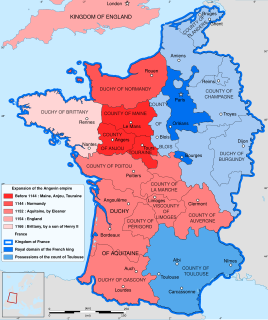Related Research Articles
William IV, called Fierebras or Fierebrace, was the Duke of Aquitaine and Count of Poitou from 963 to his retirement in 990.
William the Great was duke of Aquitaine and count of Poitou from 990 until his death. Upon the death of the emperor Henry II, he was offered the kingdom of Italy but declined to contest the title against Conrad II.

Fulk III, the Black, was an early Count of Anjou celebrated as one of the first great builders of medieval castles. It is estimated Fulk constructed approximately 100 castles, along with abbeys throughout the Loire Valley in what is now France. He fought successive wars with neighbors in Brittany, Blois, Poitou and Aquitaine and made four pilgrimages to Jerusalem during the course of his life. He had two wives and three children.
Fulk II of Anjou, called le Bon was Count of Anjou from 942 to his death.

Geoffrey I of Anjou, known as Grisegonelle, was count of Anjou from 960 to 987.
Conan I nicknamed Le Tort was the Duke of Brittany from 990 to his death.

Odo I, Count of Blois, Chartres, Reims, Provins, Châteaudun, and Omois, was the son of Theobald I of Blois and Luitgard, daughter of Herbert II of Vermandois. He received the title of count palatine, which was traditional in his family, from King Lothair of West Francia.
Hugh IV, called Brunus, was the fourth Lord of Lusignan. He was the son of Hugh III Albus and Arsendis de Vivonne. He was a turbulent baron, who brought his family out of obscurity and on their way to prominence in European and eventually even Middle Eastern affairs.
Theobald I (913–975), called the Trickster, was first viscount of Blois and viscount of Tours then, from 956, count of Blois, Chartres, and Châteaudun as well as count of Tours.

Adelaide-Blanche of Anjou was, by her successive marriages, countess of Gévaudan and Forez, of Toulouse, of Provence, and of Burgundy, and queen of Aquitaine. She was the regent of Gevaudan during the minority of her sons in the 960s, and the regent of Provence during the minority of her stepson from 994 until 999.
Herbert I, called Wakedog, was the count of Maine from 1017 until his death. He had a turbulent career with an early victory that may have contributed to his later decline.

Bourgueil Abbey was a Benedictine monastery located at Bourgueil, historically in Anjou, currently in Indre-et-Loire and the diocese of Angers. The founder was Emma of Blois, daughter of Theobald I of Blois, and by her marriage, duchess of Aquitaine.
Ermengarde of Anjou,, was the Countess of Rennes, Regent of Brittany (992–994) and also Countess of Angoulême.

The County of Anjou was a small French county and predecessor to the better known Duchy of Anjou. Its capital was Angers and it was roughly coextensive with the diocese of Angers. Anjou was bordered by Brittany to the west, Maine to the north, Touraine to the east and Poitou to the south. The adjectival form is Angevin, and inhabitants of Anjou are known as Angevins. In 1360, the county was raised into the Duchy of Anjou. This duchy later became part of the Kingdom of France in 1482 and remained a province of the Kingdom until 1790.

Agnes of Burgundy was Duchess of Aquitaine by marriage to Duke William V and Countess of Anjou by marriage to Count Geoffrey II. She served as regent of the Duchy of Aquitaine during the minority of her son from 1039 until 1044. She was a daughter of Otto-William, Count of Burgundy and Ermentrude de Roucy and a member of the House of Ivrea.
William Taillefer, numbered William II or William IV, was the Count of Angoulême from 987. He was the son of Count Arnald II Manzer and grandson of Count William Taillefer I. He stood at the head of the family which controlled not only the Angoumois, but also the Agenais and part of Saintonge. By the time of his death he was "the leading magnate in [the west] of Aquitaine[, but his] eminence ... proved temporary and illusory," evaporating on his death in succession squabbles, revolts and the predations of his erstwhile allies. The principal sources for William's career are Ademar of Chabannes and the anonymous Historia pontificum et comitum Engolismensium.
Emma of Blois was Duchess consort of Aquitaine by marriage to William IV, Duke of Aquitaine. She ruled Aquitaine as regent for her son, William V, Duke of Aquitaine, from 996 until 1004.

Aimery IV viscount of Thouars was a companion of William the Conqueror on his Invasion of England in 1066.
The County of Châteaudun was held in the 9th century by counts who also held the County of Blois. Theobald I created the first viscount of Châteaudun with the appointment of Geoffrey I, founder of the House of Châteaudun. The viscounts were entrusted with the government of the county of Châteaudun, records of whom are continuous from the mid-10th century. The actual rule of Châteaudun between the late 9th and the mid-10th centuries, and the relationships between the count and viscounts, is uncertain. The county was revived in 1439 when the region was recreated as the County of Dunois and granted to Jean Levieux Valois des Orléans, the illegitimate son of Louis I, Duke of Orléans, son of Charles V of France.
References
- 1 2 3 Abel 2012, p. 860.
- 1 2 Painter 1957, p. 30.
- ↑ Bachrach 1993, p. 184-185.
- ↑ Bachrach 1993, p. 185.
- ↑ Bachrach 1993, p. 216, 219.